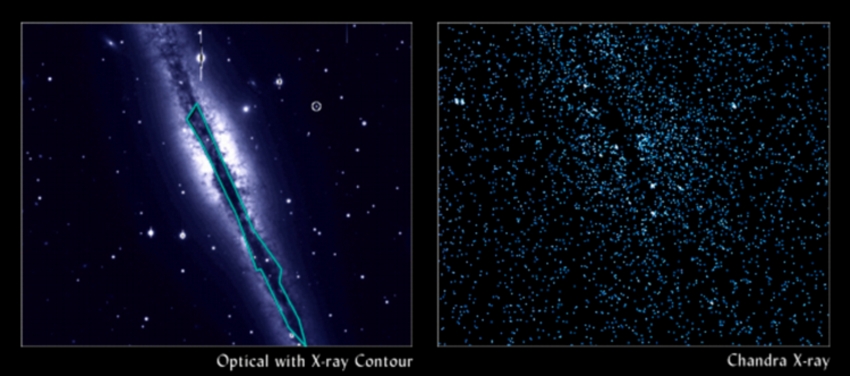
 Credit: NASA/CXC/U.Mich./J.Bregman & J.Irwin
Credit: NASA/CXC/U.Mich./J.Bregman & J.Irwin
The Great Beyond
Astronomers have a hard time getting distances even to discrete objects. Imagine
how hard it is to determine the distance to diffuse emission. The only recourse
astronomers have in such cases is to observe a discrete source and to try to
determine whether the diffuse emission is in front of or behind the object.
X-ray astronomers have a particularly hard job in this regard, since a
mysterious X-ray "background" seems to permeate the universe - but where does it
come from? The ROSAT X-ray Observatory
showed that at least some of the x-ray background came from beyond the
moon, and that some of it came from beyond
nearby molecular clouds outside the solar system but within our galaxy. The
Chandra X-ray Observatory has now
pushed the limit beyond our galaxy. Chandra recently obtained an X-ray image of
the edge-on galaxy NGC 891. Like all spirals, NGC 891 has a relatively thin
disk of gas and dust, and, because we view the galaxy edge-on, this disk shows
up as a dark lane splitting the galaxy, as shown in the optical image on the
above left. The Chandra X-ray image (above right) shows rather faint X-ray
emission from the galaxy - but there's almost no x-rays from the disk of the
galaxy where the gas and dust are thickest. This shows that at least some of the
background X-rays originate beyond NGC 891 - perhaps in a vast, distant
intergalactic cloud of multimillion degree gas.
Last Week *
HEA Dictionary * Archive
* Search HEAPOW
* Education
Each week the HEASARC
brings you new, exciting and beautiful images from X-ray and Gamma ray
astronomy. Check back each week and be sure to check out the HEAPOW archive!
Page Author: Dr. Michael F. Corcoran
Last modified August 5, 2002


